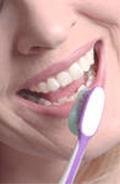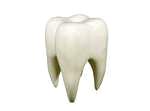|
|
"The greatest wealth is health." Virgil |
Time to solve teeth troubles

Throughout your life you end up having 2 completely different sets of teeth. The initial set is the baby teeth (deciduous teeth) that eventually fall out. They are whiter, softer, and less sturdy than adult teeth. Hence, they tend to wear out much faster than permanent teeth, but they also fall out to make room for them. Making sure that there's enough space in the vacancy caused by a lost baby tooth is important for healthy adult teeth. Your teeth are by far one of the most important things you use every day. Many people end up neglecting their teeth with improper oral hygiene. You should take care of them by brushing at least twice a day, flossing once per day, and going for regular dental checkups at least twice per year. New developments include the implantation of artificial teeth or binding posts into the gums or jawbone; antibiotic fiber for periodontal disease; root canal surgery, a procedure that ameliorates pain while permitting teeth to remain in place; and nearly painless lasers to repair dental cavities, usually making local anesthesia unnecessary. Implants are great for replacing missing teeth. It is important that you have enough bone in the area of the missing teeth for the implants to be attached to. Implants are not only used to replace one tooth, but rather people missing most, if not all, of their teeth benefit greatly as well. Implants are increasingly being used to replace certain types of bridges and removable partial dentures. Implants are surgically placed in your jaw bone while under anesthesia. It is a very time consuming procedure when having many implants placed. As this procedure is surgical, it is very important to research and find a well credited cosmetic dentist that you are comfortable with. For some people there are varying degrees discomfort or pain, which subsides in a couple of days. As with similar types of surgery, bruising and minor swelling might also develop shortly after the procedure. When missing one tooth, your cosmetic dentist may use a Flipper to fill the space. A Flipper is a false tooth to temporarily take the place of a missing tooth before the permanent crown is placed on the implant. A Flipper can be attached via either a wire or a plastic piece that fits in the roof of your mouth. Flippers are meant to be a temporary solution while awaiting the permanent crown to be placed on your implant(s). This section of our cosmetic dentistry information site provides you with some background into dental veneers, both composite veneers and porcelain veneers. Dental veneers, sometimes called tooth veneers, can be used to correct both color and shape problems. Veneers provide a durable solution to the color and shape problems that are common to so many people. Veneers are applied to fronts or visible areas of the teeth. The enamel (outside layer of the tooth) is ground down or reduced by just fractions of a milimeter in order to allow for the thin (contact lense thickness) veneer to be permanently attached to the tooth. Dental veneers (sometimes called porcelain veneers or dental porcelain laminates) are wafer-thin, custom-made shells of tooth-colored materials designed to cover the front surface of teeth. These shells are bonded to the front of the teeth changing their color, shape, size or length and resulting in an improved appearance. While no alternative to veneers will create the exact same effect, there are some popular procedures that may seem worthwhile. Crowns, while more expensive, also act to cover the tooth with a protective coating. For individuals who simply want to brighten their teeth, many clinics now offer tooth bleaching, though this is a much less permanent procedure. The dental bonding procedure utilizes a composite resin and is used for a variety of structural as well as cosmetic purposes. One can draw a parallel between dental bonding materials and a sculptor's clay. By using dental composite resin bonding your dentist can restore chipped or broken teeth, fill in gaps and reshape or recolor your smile. Basically, bonding will cover any natural flaws applying a thin coating of a plastic material on the front surface of your teeth. After this, your cosmetic dentist will apply a bonding material and sculpt, color and shape it to provide a pleasing result. A high-intensity light then hardens the plastic, and the surface is finely polished. The resin comes in many shades so that we can match it to your natural teeth. Due to the layers involved, this procedure will take slightly longer than traditional silver fillings because multiple layers of the bonding material are applied. Typically bonding takes an hour to two hours depending on your particular case.
Definition interpretationStomatology Tooth bleaching Get your implants in czech dental clinic
|
|
